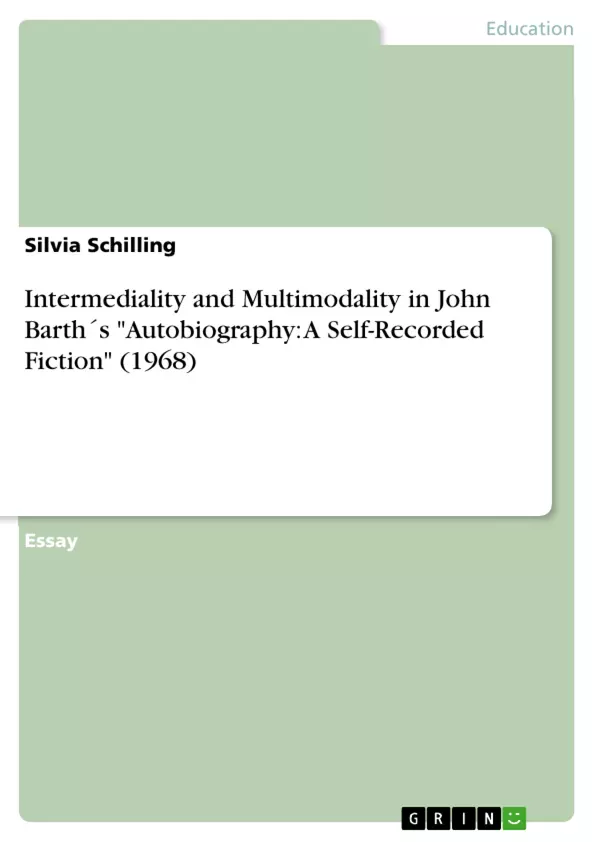This essay analyses John Barth´s short story "AUTOBIOGRAPHY: A Self-Recorded Fiction”, which was published inf the short story collection ´Lost in the Funhouse´ in 1968. The story is examined from the perspective of an intermediality / multimodality scholar. Among other things, the essay discusses the employment of several media / modes within the story and reveals limits inherent to the theories of intermediality and multimodality, pointing to the concept of heteromediality as a possible alternative.
Inhaltsverzeichnis (Table of Contents)
- Introduction
- The Concept of 'Medium' and 'Mode'
- The Short Story as Intermedial and Multimodal Text
- Formal Features: Spatial Configuration and Font
- The Narrative and the Medium of Speech
- Intermedial References and 'Fictional Medial Transposition'
- The Blurring of Boundaries Between Media
- Conclusion
Zielsetzung und Themenschwerpunkte (Objectives and Key Themes)
This essay investigates the short story "AUTOBIOGRAPHY: A Self-Recorded Fiction" by John Barth from an intermedial and multimodal perspective. It examines how the text challenges traditional notions of written narratives by employing different media and referring to the relationship between written language and other modes. The essay explores the ambiguities and challenges related to the concepts of 'medium', 'intermediality', and 'mode'.
- The concept of 'medium' and its diverse manifestations
- The relationship between written language and other semiotic modes
- The use of spatial arrangement and typography as meaning-constitutional strategies
- The blurring of boundaries between media and the challenges for 'intermediality'
- The concept of 'heteromediality' and its potential application
Zusammenfassung der Kapitel (Chapter Summaries)
- Introduction: This section sets the stage by introducing the story and its unconventional approach to narrative. It highlights the challenge of defining terms such as 'intermediality', 'medium', and 'mode' when analyzing such a text.
- The Concept of 'Medium' and 'Mode': This section delves into the ambiguity of the term 'medium' by exploring various scholars' attempts to define it. It introduces the concept of 'mode' as a semiotic resource that can be realized in different media.
- The Short Story as Intermedial and Multimodal Text: This section argues that Barth's story, despite being primarily written, employs different media and modes, challenging the notion of monomodality in literature. It analyzes how the story refers to orality, visual aspects of reading and writing, and potentially even drama.
- Formal Features: Spatial Configuration and Font: This section analyzes the deliberate use of spatial arrangements within the story. It explores how gaps between words and sentences contribute to meaning and create a temporal effect on the reading process. It also discusses the semantic implications of font choices, including italics and capitalization.
- The Narrative and the Medium of Speech: This section examines the story's fictional origin account, where it is presented as the product of a writer's voice recorded by a machine. It explores the concept of 'medial transposition' and how the story intertwines oral and literary culture.
- Intermedial References and 'Fictional Medial Transposition': This section continues the analysis of intermediality in the story, focusing on the relationship between orality and writing. It argues that blank spaces within the text could be seen as media-specific means of referencing orality. It also discusses the potential inclusion of dramatic elements.
- The Blurring of Boundaries Between Media: This section discusses the challenge of 'intermediality' in a world where all media are inherently mixed. It introduces the term 'heteromediality' as a potential alternative to 'intermediality' and 'multimodality' in order to acknowledge the blending of media in all texts.
Schlüsselwörter (Keywords)
This essay focuses on the key concepts of intermediality, multimodality, medium, mode, heteromediality, spatial configuration, typography, orality, and fictional medial transposition. It investigates how these concepts apply to John Barth's short story "AUTOBIOGRAPHY: A Self-Recorded Fiction" and how the text challenges traditional notions of written narratives.
- Citar trabajo
- B.A. Silvia Schilling (Autor), 2018, Intermediality and Multimodality in John Barth´s "Autobiography: A Self-Recorded Fiction" (1968), Múnich, GRIN Verlag, https://www.grin.com/document/451167



